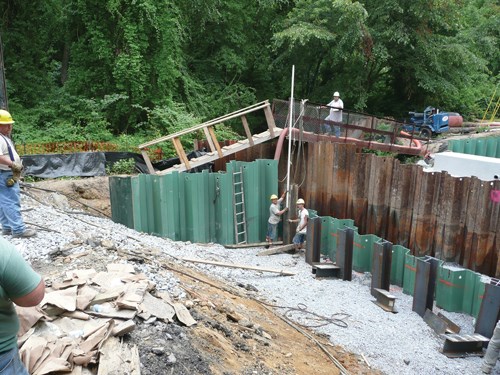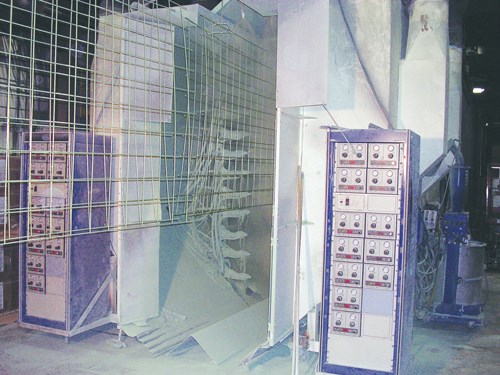Piling on for Powder Coatings
Lane Coatings targets construction market with fusion-bonded powder coatings, and are espousing the benefits of using the coatings on materials such as pilings and reinforcement bars used in road and bridge construction.
If it’s Tuesday, then Lane Coatings’ Gene Anderson must be driving to a meeting with an official from a department of transportation, or maybe a civil engineering group, to speak about the benefits of using powder coating in construction projects.
No, wait. Make that most every day that Anderson and others at Lane—plant manager Todd Strohm and custom coating manager Gary Hinkelman included—are espousing the benefits of using powder coatings on construction materials such as pilings and reinforcement bars used in road and bridge construction.
“Powder coating is starting to be used more and more in these areas, but not as much as we’d like,” says Anderson, sales manager for Lane Enterprises in Carlisle, Pa., the parent company of the coating division.
“It really comes down to getting the word out to the people in charge of these projects that powder coating is a much better product to use than coal tar epoxy. The more we tell people, the more they listen, and the more progress we make,” he says.
Fusion-Bonded Epoxy
Lane Coatings has been at the forefront of pushing fusion-bonded epoxy powder coatings as a replacement for coal tar epoxy, which has been used for decades to prevent corrosion in materials such as steel, galvanized aluminum and concrete. It is an oil-based substance that emits a definitive tar smell, and is often difficult to handle and apply.
“Coal tar always seems to get the nod because it’s cheaper, but its longevity is bad and it’s really a nasty coating that is hard to apply in the winter,” Anderson says. “We went to our main suppliers—Valspar and 3M—about three years ago and said, ‘Let’s start promoting the benefits of powder coatings,’ and its the mission we are on.”
Besides epoxy, Lane applies other powder coatings such as polyester; hybrid; zinc-rich primer; and organic, liquid zinc-rich primer. Its facilities can handle extremely long parts of as much as 120 ft long, 4 ft wide, and 9 ft high, with a maximum part weight of 18 tons.
Lane and its suppliers started out by targeting the piling industry, which uses metal walls and pipe that are driven into the ground to support buildings and other structures. The company was no stranger to construction applications, having started out in 1979 coating steel reinforcement bars for the construction industry.
Million Dollar Bridge
In 1986, Lane added a second rebar coating line, and later that year landed one of its biggest jobs as a young company when the Million Dollar Bridge in Portland, Maine, was hit by a runaway barge, damaging a bridge support and stopping traffic on the drawbridge for weeks.
For decades, the Maine Department of Transportation had been planning to replace the bridge, and it hired Lane Coatings to apply a protective powder coat over about 40 steel pipes it used on the project that were each 3 ft in diameter and 109 ft long.
The Million Dollar Bridge project led to more work from other state agencies, and in 1989, Lane Coatings added a 35,000-sq-ft building to house a new custom coating line. In 1995, it converted the second rebar line to custom coatings.
Fusion-bonded epoxy (FBE) has been around since the 1960s, used mainly in the pipeline industry because of its corrosion protection properties. The coating is called fusion-bonded because of a chemical reaction that causes a cross-linking of the resins in the powder coating, which prevents the movement of the components once the reaction has taken place.
While not used extensively, FBE powder coatings have received the endorsements of civil and architectural engineers, as well as a rave review from the U.S. Army Corps of Engineers (USACE), who issued a report as far back as 1995, stating that the coatings had “excellent barrier properties.”
Coal Tar Epoxy Toxicity
One of the reasons for the USACE study was continued concern from federal agencies regarding the toxicity of coal tar epoxy and epoxy polyamide coatings in use at the time, especially because the products were using a mixture of resins, coal tar pitch, an accelerator, solvents and rheological modifiers.
“While each of the components has associated hazards, coal tar pitch may be especially hazardous,” the USACE researchers wrote in 1995. “Coal tar pitch volatiles are a confirmed human carcinogen as well. While most organic coating materials are far from benign, these two factors warrant the investigation of alternative technologies to replace or supplement the use of Corps of Engineers paint specifications.”
With those warnings in hand, the researchers also found that FBE powder coatings performed extremely well—if not better—in testing in soil, ocean water and atmospheric conditions.
“The better performing FBE coatings may be expected to provide similar levels of corrosion protection in immersion and atmospheric exposure in comparison with standard Corps systems,” the report said, adding that “the FBE coatings have superior resistance to impact damage. Coatings that are more resistant to impact damage may exhibit superior long-term performance.”
And that is exactly the message Lane’s Anderson, Strohm and Hinkelman have been delivering through the Northeast region of the U.S., meeting with state and local agencies about getting FBE into more projects, and hopefully replacing coal tar as the coating of choice.
Research Data
Anderson held several lunch meetings with groups of engineers and government regulators, all to show them how his shop in Carlisle could provide a better product. Anderson also worked with his suppliers to get real data to show the gathered masses, and that research had to show that FBE coatings would last just as long and perform as well as what they had been using.
Lane Coatings partnered with 3M on a study of a project they collaborated on in the Bahamas, where “Z piles” coated by Lane with 3M’s Scotchkote FBE powder coating were used in several projects, the first time piles were coated with 3M’s dual coat system of Scotchkote 226N/6352.
Anderson said that Lane applied a nominal thickness of about 15 mils of Scotchkote 226N and 25 mils of Scotchkote 6352 to the Z piles, which are heavy gauge ¾- to 1-inch or greater steel piles in the shape of a Z, usually about 20-30 feet in length. The piles are tongue and grooved so that they interlock to form a continuous barrier, typically used in retaining walls.
When the piles are installed, they are vertically stood on end and held in place by a temporary steel frame until about 25 piles are in a line, where they are then power driven into the ground with a large pneumatic driver attached to a crane. When the driving is finished, only about five feet of the pile is left above ground,
While the coating sustained minimal damage during installation in the Bahamas projects, several piles were later removed and noted that there were no areas where the topcoat Scotchkote 6352 was completely removed down to the base Scotchkote 226N, thus leaving the protection intact.
Superior Performance
“We know that our coatings are going to be a little more expensive, and we know we will lose business because of that, but there is no question that the epoxy powder coatings can perform the job that these engineers want it to perform,” says Anderson.
Valspar and 3M are not the only makers of FBE powder coatings, nor are they the only companies pushing the technology into more mainstream uses than just pipes and energy components.
Axalta Coating Systems’ Nap-Gard epoxy powder coatings have been around since the mid-1950s, but are mostly used today in coating pipe with epoxy coatings for the oil and gas industry.
But Anderson says the big push to get more powder coating used in the construction projects will come about when FBE epoxy coatings get specified into projects by the engineers and regulatory agencies that oversee most of the road, bridge and building projects in the U.S.
“The key will be getting more powder coating specified into the process from the beginning,” Anderson says. “And we are working with entities. We just went up to Maine and had discussions with those people about getting the epoxy specified in, so it’s a work in progress. It’s always evolving.”
Piling Industry
Meanwhile, Lane Coatings is hoping to get more ingrained into the piling business. The company joined the Pile Drivers Contractors Association and other trade groups in hopes of meeting those in the industry and fostering new relationships.
“We think we have the advantage over other coaters who do the pipe piling because those guys can’t do the sheet and the H piles,” Anderson says. “We’ve got a 120-foot long oven, so we can handle just about anything. It’s a real advantage for us.”
Anderson, Strohm and Hinkelman will continue to plug away at promoting FBE epoxy powder coating, hoping to move the needle on getting additional work from pile driving projects and other materials that previously may have used coal tar.
Lane is also checking into the solar energy market, where canopies and roofs are being constructed over parking lots, and solar panels are used as the roof material. The customer then catches the sun’s rays and harvests the energy, selling it back to the electric company.
“There are a lot of options out there than just what the everyday coater has been going after,” Anderson says. “We’ll go talk to anybody anywhere to get their work.”
For more information on Lane Coatings, please visit Lanecoatings.com
Related Content
Oven System Wins Pace Award
The EcoInCure is designed to cure complex car bodies with superior paint quality faster and more efficiently than conventional ovens.
Read More‘Warming Up’ to the Truth about Ovens for Surface Treatment
Understanding the different types of oven heat technology for surface finishing, including how they work, and their advantages and disadvantages, can help determine the best heating solution for an application.
Read MoreQuick Turnaround is Key for Architectural Coating Shop
This California metal fabricator and coater focuses on fast turnaround and streamlining its processes with 40 years of experience in the construction industry.
Read MoreHybrid Oven Features Catalytic and Electric Infrared Technology
Source: Trimac Trimac Industrial Systems will be featuring our new innovation, the Pro-Cat oven.
Read MoreRead Next
Delivering Increased Benefits to Greenhouse Films
Baystar's Borstar technology is helping customers deliver better, more reliable production methods to greenhouse agriculture.
Read MoreEducation Bringing Cleaning to Machining
Debuting new speakers and cleaning technology content during this half-day workshop co-located with IMTS 2024.
Read More
























